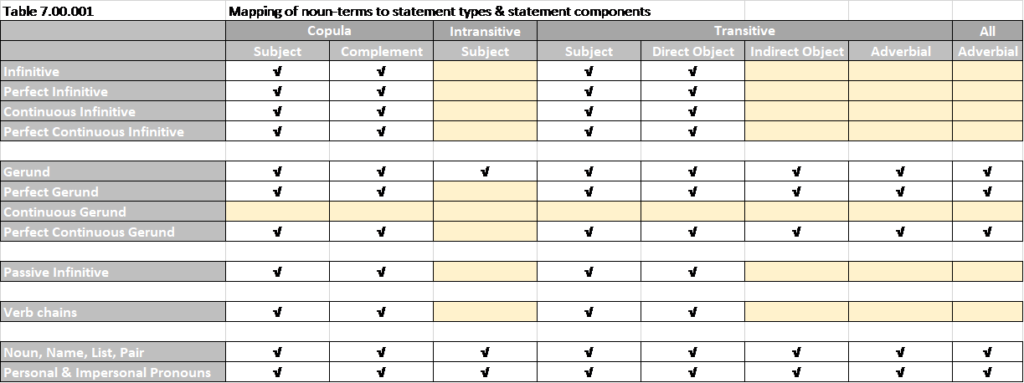Verb chains are a means of placing multiple ideas into the same term by stringing together infinitives and gerunds. The equivalent structures for nouns and pronouns are lists and pairs. These are composite grammatical structures that can be used wherever a single noun, pronoun or name can be used. A noun or pronoun refers to only one entity whereas a pair refers to two entities and a list refers to multiple entities.
There are no restrictions with regard to the use of pairs, lists, nouns and names. They can be used as both the subject and complement with a copula, as the subject with an intransitive verb, as the subject, direct object and indirect object with a transitive verb and in a prepositional phrase as part of an adverbial component.
These constructions complete the set of possible noun-terms. As the table demonstrates, the number of different possibilities creates a great deal of complexity.

Pairs & Lists
Pairs are constructed with an introductory term that identifies the logical type of structure and therefore the conjunction that will sit between the terms.
The introductory term is adjective, sometimes with a modifying adverb, which indicates the logical relationship of the pair and therefore governs the conjunction. These constructions are classified as co-ordinating conjunctions.
These conjunctions are not the only ones available. For example, both…and could be replaced by not only…but also.
The adverbs whether and not can also be used with the other forms to indicate doubt: for example, we could say whether (or not) both pedestrians and motorists can use the highway is unclear.

Once a pair has been enumerated it becomes possible to use adjectives with prepositional phrase (see section 9) to create a simpler structure. In this case, doubt can be expressed either by posing a question or by using the adjective whichever.

Lists are similar except that because there are more terms there are more logical possibilities. Although lists in principle can contain any number of items, in practice issues of style and idiom limit the extent of a list. As with pairs, the adverbs whether and not can be used to qualify the adjective to convey doubt.

In order to refer to the contents of a list, a pronoun qualified by an adjective of selection or quantification can be used.

These constructions can be compared with the set of impersonal pronouns which apply to the universal domain. This is discussed further in section 11 below.

Nouns & Names
Names, sometimes called proper nouns, refer to and identify individual entities. Names are said to have a denotation; they denote something.
Nouns, also sometimes called common nouns to distinguish them from names, are abstract terms that identify types of entity. Nouns have a connotation rather thana denotation. In order to refer to an individual entity, nouns must be qualified by an addressing mechanism, a pointer or indexical.
There are a number of methods. One is to use a determiner, which can be an article, a demonstrative adjective or a possessive adjective (see section 8.1 below), optionally accompanied by a restrictive adjective (see section 8.2). A second method is to use a restrictive relative clause (section 12.2).
In other cases, the objective is to narrow down the target rather than to identify a particular individual entity. In this case another set of determiners can be used to narrow the selection or quantify the reference (section 8.3).
Nouns may also be qualified by non-restrictive adjectives (see section 8.4) and non-restrictive relative clauses (see section 12.3).
Adjectives may themselves be further qualified by adverbs. This means that, more often than not, nouns are components of noun-phrases.
Nouns and names are both the largest class of words and the least constant. The lexicon is continually being added to as new terms are needed in every domain while old terms that are no longer needed fall into disuse.
